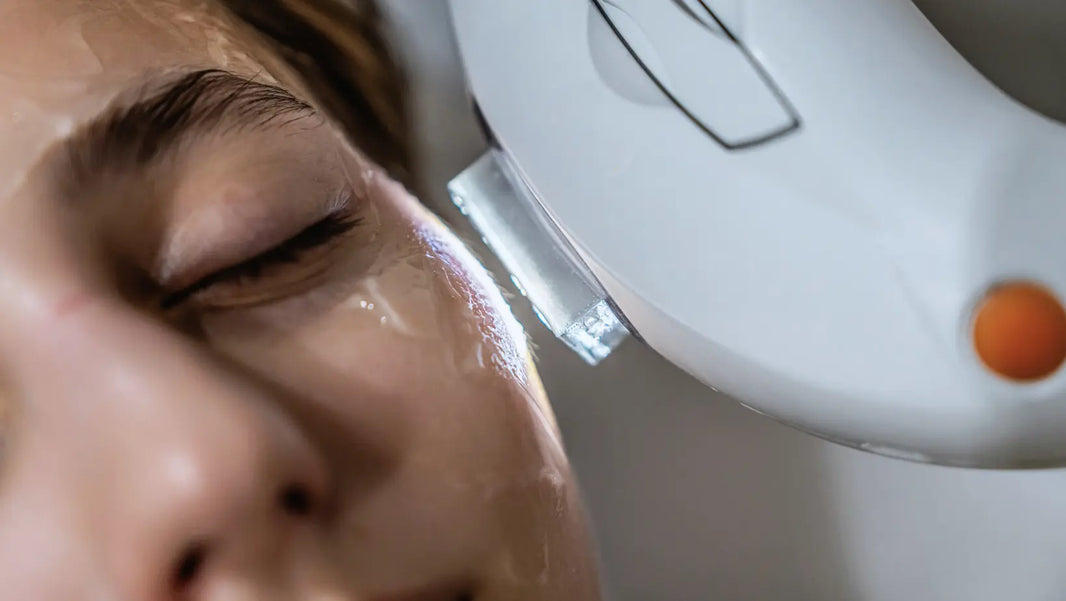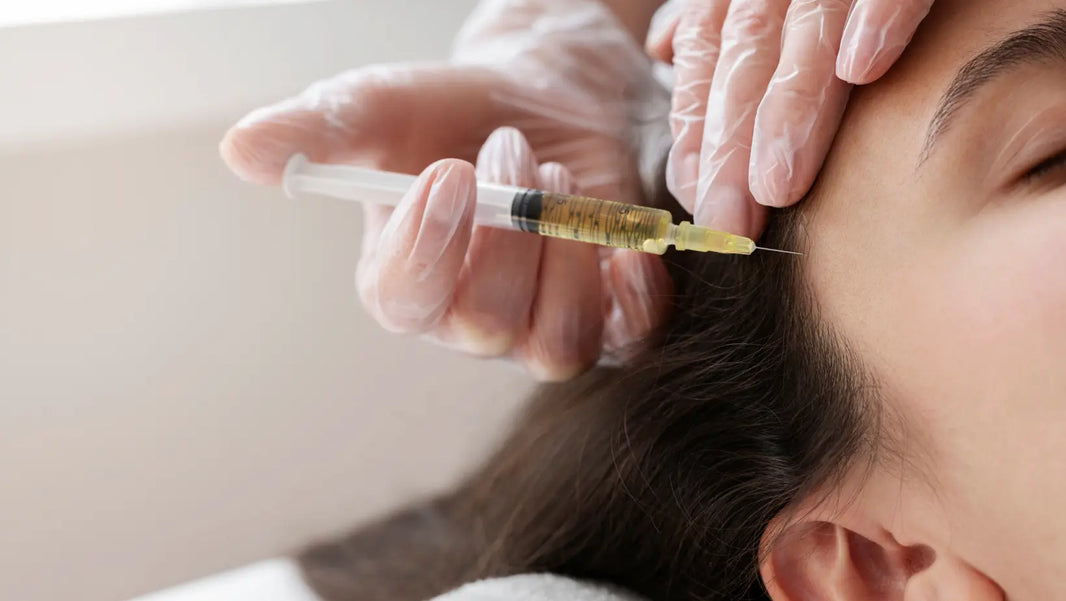The skincare world has witnessed countless "revolutionary" treatments come and go. But every so often, something genuinely transformative emerges - a convergence of science and innovation that fundamentally changes what's possible.
Exosome microneedling represents one of those rare breakthroughs.
This isn't just another aesthetic trend or marketing buzzword. It's a sophisticated fusion of two powerful technologies: the proven collagen-inducing effects of microneedling and the cutting-edge cellular communication capabilities of exosomes. Together, they're rewriting the rulebook on how we approach skin rejuvenation, scar treatment, and regenerative healing.
Whether you're battling stubborn acne scars, fighting the visible signs of aging, dealing with melasma, or exploring solutions for hair loss, this comprehensive guide will help you understand how exosome microneedling works, what the science actually says, and whether it's the right approach for your specific concerns.
The Foundation: Understanding Microneedling and Exosomes
Before we dive into specific applications, let's establish the fundamentals.
Microneedling 101
Microneedling - also called collagen induction therapy - uses a device equipped with ultra-fine needles (typically 0.5mm to 2.5mm in length) to create thousands of controlled micro-injuries in the skin. This triggers your body's natural wound-healing cascade, ramping up collagen and elastin production while encouraging cell renewal and repair.
Research published in the Journal of Cutaneous and Aesthetic Surgery1 confirms significant increases in both collagen type I and type III following microneedling treatments. Studies in Dermatologic Surgery show measurable improvement in atrophic acne scars after just four sessions.
But here's the game-changer: those micro-channels created by the needles dramatically enhance absorption of topical treatments - increasing penetration by up to 1000% compared to intact skin.
Enter Exosomes: The Cellular Messengers
Exosomes are nanosized vesicles (30-150 nanometers) secreted by stem cells that carry growth factors, peptides, and RNA to stimulate skin cell repair and communication. Unlike traditional serums that sit on the surface, exosomes are designed by nature to penetrate cell membranes and deliver regenerative cargo directly where it's needed.
The source matters significantly:
- Human-derived exosomes (from mesenchymal stem cells): Show the highest bioactivity and compatibility - considered the gold standard
- PRP exosomes: Harvested from your own blood, offering excellent biocompatibility but variable potency
- Plant-based exosomes: Appeal to vegan consumers but research suggests lower potency for human skin regeneration
Research in Stem Cells Translational Medicine2 demonstrates that exosomes significantly accelerate tissue repair. The International Journal of Molecular Sciences confirms their ability to regulate inflammation and balance pigmentation.
When you combine the absorption-enhancing channels of microneedling with the regenerative power of exosomes, you create a synergistic effect that's greater than either treatment alone.
What to Expect: Investment and Timeline
Before we explore specific applications, let's talk practicalities.
Cost Per Session:
- Face alone: $500-1,000
- Face + neck: $700-1,200
- Scalp treatments: $800-1,500
- Large body areas: $1,000-1,800
Sessions Needed:
- Maintenance: 2-3 sessions
- Moderate concerns: 4-6 sessions
- Significant issues: 6-8+ sessions
Downtime: Days 0-1: Redness and sensitivity (like moderate sunburn) Days 2-3: Fading to pink, possible light flaking Days 4-7: Most effects resolved, return to normal skincare
Results Timeline: Weeks 1-2: Initial glow from circulation Month 1: Early texture improvements Months 2-3: Significant changes as collagen production accelerates Months 4-6: Peak results Months 6-12: Continued subtle improvement
Patience is essential - collagen remodeling unfolds over months, not days.
Microneedling with Exosomes and Polynucleotides
As exosome science has evolved, practitioners discovered that combining multiple regenerative ingredients can amplify results even further.
Polynucleotides (PNs) - DNA fragments typically derived from salmon or trout - bring complementary benefits to the exosome party. While exosomes excel at cellular signaling, polynucleotides focus on structural support.
The Synergistic Effect
Think of it this way: exosomes are the master communicators, telling your cells what to do. Polynucleotides are the construction workers, providing the raw materials and structural framework for repair.
Together, they create a dual-action approach:
- Exosomes handle regenerative signaling and cellular repair
- Polynucleotides boost hydration, elasticity, and tissue density
What You'll Notice
Patients receiving this combination consistently report:
- Faster post-procedure recovery (often 1-2 days less downtime)
- Improved skin tone and firmness that feels almost architectural
- Reduced redness and inflammation
- More dramatic overall results compared to exosomes alone
Is the Premium Worth It?
This combination typically runs $800-1,500 per session compared to $500-1,000 for exosomes alone. Many patients find the enhanced results worth the investment, particularly for advanced aging concerns or significant scarring where you want maximum regenerative power working in your favor.
The key question: Are you seeking good results or exceptional results? If you're already committing to the process, the incremental investment in polynucleotides often delivers disproportionate benefits.
Microneedling with Exosomes for Hair Growth
Hair loss can be devastating - I've watched friends struggle with treatments that promise the world but deliver underwhelming results or unwanted side effects. Exosome microneedling offers a different path forward.
How the Science Works
Microneedling on the scalp serves dual purposes: it creates channels for enhanced exosome absorption and stimulates blood flow to follicles. The exosomes then promote follicle stem cell renewal, extend the anagen (active growth) phase, and reduce inflammation that contributes to hair loss.
Clinical research published in Stem Cell Research & Therapy3 reported that patients receiving foreskin-derived MSC-exosome injections for androgenetic alopecia experienced a statistically significant improvement in hair density — increasing from approximately 149.7 ± 13.7 hairs/cm² before treatment to 157 ± 18.3 hairs/cm² after 12 weeks.
Your Realistic Timeline
Let's be honest about expectations:
Months 1-2: Reduced shedding - you'll notice less hair in the shower drain Months 3-4: Baby hairs appearing along the hairline (exciting but still subtle) Months 6-9: Noticeable density improvement that others comment on Maintenance: Quarterly sessions to sustain results
Who Benefits Most
This approach works best for:
- Androgenetic alopecia (pattern baldness)
- Telogen effluvium (stress or nutritional hair loss)
- Thinning due to hormonal changes
It's less effective for:
- Complete baldness where follicles are long dormant
- Scarring alopecia where follicles are destroyed
The Treatment Experience
Most patients describe scalp microneedling as uncomfortable but tolerable - like someone firmly scratching your head with a stiff brush. Topical numbing cream helps significantly. You'll leave with a pink scalp and some tenderness, but you can typically return to normal activities the next day.
The exosome serum feels cooling and soothing post-treatment, which is a welcome relief after the needling.
Microneedling with Exosomes Under Eyes
The under-eye area is where we often first notice aging. It's also the most technically challenging area to treat - which means choosing an experienced practitioner is absolutely critical.
Why This Area Is Unique
The periorbital skin is remarkably thin (about 0.5mm compared to 2mm on the cheeks), making it more prone to showing every blood vessel, shadow, and structural change. It's also prone to fluid retention, which creates those infamous under-eye bags.
What Exosomes Address
By enhancing microcirculation and stimulating targeted collagen synthesis, exosomes can:
- Reduce puffiness and fluid accumulation
- Soften crepey texture and fine lines
- Brighten dark circles caused by thin skin or vascular visibility
Research shows that exosomes improve skin thickness at the cellular level, which is exactly what under-eye hollows need.
The Critical Safety Requirements
Here's where you cannot compromise: under-eye microneedling requires gentle depth settings (0.25mm or less - barely deeper than the epidermis) and should only be performed by experienced practitioners using sterile, medical-grade exosome serums.
The risk of bruising, swelling, or infection is significantly higher here due to delicate tissue and proximity to the eyes. I've seen poorly executed treatments leave patients with weeks of bruising that makeup couldn't cover.
What to Expect
You'll need 3-4 sessions spaced 4-6 weeks apart. Results become visible after the second treatment and continue improving for 3-6 months as collagen remodels.
Expect noticeable swelling for 2-3 days post-treatment in this area - plan accordingly. Cold compresses and sleeping with your head elevated help minimize puffiness.
The Honest Assessment
Under-eye microneedling with exosomes can produce remarkable improvements, but it won't replace lost volume or eliminate severe bags. For those concerns, you may need complementary treatments like filler or surgical intervention. The best practitioners will tell you this upfront rather than overpromising.

Microneedling with Exosomes Around Eyes
Treating the area surrounding the eyes - particularly crow's feet and lateral concerns - requires a slightly different approach than direct under-eye treatment.
The Distinction Matters
While under-eye treatment focuses on the delicate infraorbital area with extremely shallow needling, treating around the eyes (the orbital rim and lateral eye area) can handle slightly deeper penetration (0.5-1.0mm) because the skin has more structural integrity.
This is where crow's feet live - those expression lines that deepen over time as collagen breaks down and skin loses elasticity.
The Treatment Approach
Practitioners typically work in zones:
- Outer orbital area (crow's feet): Medium depth needling with exosome application
- Temple area: Can be treated more aggressively
- Upper lid: Requires extreme caution or is avoided entirely
Comfort and Recovery
This area is surprisingly sensitive. Most practitioners use a topical numbing cream and apply cooling gel patches post-procedure to minimize discomfort and reduce swelling.
You'll likely experience more pronounced swelling around the eyes than with facial treatment elsewhere - this is normal due to the loose tissue structure. Don't be alarmed if you wake up the next morning looking a bit puffy. It resolves within 2-3 days.
Combining Treatments
Many patients pursue both under-eye and around-eye treatment in the same session for comprehensive periorbital rejuvenation. This makes sense from both an aesthetic and financial perspective, though it does mean a more noticeable recovery period.
The key is finding a practitioner who understands the anatomical nuances and adjusts technique, depth, and product application accordingly. The eye area isn't where you want someone learning on the job.
Microneedling with Exosomes While Pregnant
This is one of the most common questions I receive, and I understand why - pregnancy often brings skin changes like melasma, acne, or increased sensitivity, making effective treatments even more appealing.
The Direct Answer: No
Microneedling with exosomes is not recommended during pregnancy or while breastfeeding.
The Reasoning
While exosomes are naturally derived biological materials, there's currently insufficient clinical data regarding their use during pregnancy or lactation. We simply don't have the research to confirm safety for developing babies or nursing infants.
Beyond the exosome question, pregnancy itself creates complications:
- Hormonal fluctuations increase risks of post-inflammatory hyperpigmentation
- Infection risk may be elevated due to immune system changes
- Skin sensitivity is often heightened, potentially increasing discomfort
- Some numbing agents used during procedures aren't pregnancy-safe
The American College of Obstetricians and Gynecologists4 advises caution with aesthetic procedures during pregnancy, and most reputable practitioners will defer treatment until after breastfeeding concludes.
Alternative Approaches
Pregnancy skin concerns are real and deserve attention. Consider these safer alternatives:
- Gentle enzyme peels
- LED light therapy (after consulting your OB)
- Medical-grade skincare focused on hydration and barrier support
- Pregnancy-safe vitamin C serums
Looking Ahead
Many women find that skin concerns that emerged during pregnancy resolve naturally postpartum as hormones stabilize. If issues persist after breastfeeding, exosome microneedling can be an excellent option for addressing lingering melasma, texture changes, or acne scarring.
Your skin will still be there in a year, and treating it safely and effectively then is far better than risking complications now.
Microneedling with Exosomes for Stretch Marks
Stretch marks (striae) are one of those concerns that feel permanent - those silver or purple lines that map out our body's history of growth, pregnancy, or weight changes. They form when rapid expansion causes the dermal collagen matrix to literally rupture.
While they eventually fade from purple/red to silver-white, the textural change remains visible. Traditional creams barely make a dent. But regenerative treatments offer real hope.
How the Treatment Works
Microneedling with exosomes attacks stretch marks on multiple fronts:
- Breaking down disorganized scar tissue
- Stimulating new collagen and elastin formation
- Improving skin thickness and elasticity in affected areas
- Enhancing cellular communication to optimize healing
The exosomes are particularly powerful here because stretch marks represent disrupted tissue that needs comprehensive regenerative signaling to rebuild properly.
Setting Realistic Expectations
Complete elimination is unlikely - I'd be lying if I promised otherwise. But significant improvement is genuinely possible:
- Newer stretch marks (red/purple): 60-80% improvement
- Older stretch marks (white/silver): 30-50% improvement
- Texture: Becomes smoother even when pigment changes remain
The depth and width of stretch marks influence outcomes. Wider, deeper marks require more sessions and show more modest improvement than fine, shallow marks.
The Enhanced Protocol
For optimal results, many practitioners recommend combining exosome microneedling with topical retinoids applied 2-3 weeks post-treatment. This one-two punch maximizes collagen remodeling.
The typical protocol:
- 6-8 sessions spaced 4-6 weeks apart
- Deeper needling than facial treatments (1.5-2.5mm)
- Liberal application of exosome serum
- Post-treatment barrier support
The Investment Consideration
Treating stretch marks often requires addressing larger body areas (abdomen, hips, thighs), which means higher costs per session ($1,000-1,800). With 6-8 sessions recommended, you're looking at a significant investment.
That said, patients who commit to the full protocol consistently report that seeing their stretch marks fade - even partially - has a profound impact on confidence and comfort in their own skin.
Microneedling with Exosomes for Acne
Acne and its aftermath represent two distinct challenges that exosome microneedling addresses - though the approach differs based on your current skin state.
For Active Acne
Exosomes demonstrate impressive anti-inflammatory properties that can calm reactive skin. Various research shows they help regulate sebum production, reduce inflammatory cytokines, and support skin barrier function.
Critical Caveat: Microneedling should never be performed over active pustules or cystic acne due to infection risk and the potential to spread bacteria. Treatment focuses on unaffected areas while exosomes work systemically to reduce overall inflammation.
If you're dealing with active breakouts, you'll likely need to get acne under control with medical management (topicals, oral medications, or other treatments) before pursuing microneedling.
For Acne Scarring: Where This Really Shines
This is where exosome microneedling truly excels. Atrophic (depressed) acne scars result from collagen loss during the inflammatory healing process. By creating controlled injury and delivering regenerative exosomes directly into scar tissue, you stimulate new collagen formation that gradually raises the scar floor.
Understanding Scar Types and Outcomes:
- Ice pick scars (deep, narrow): Moderate improvement (40-60% reduction)
- Boxcar scars (wider with defined edges): Good improvement (60-75% reduction)
- Rolling scars (wave-like undulations): Excellent improvement (70-85% reduction)
The Treatment Journey
Realistic timelines require 4-6 sessions for significant results. I've watched friends go through this process - the first session often shows minimal change, which can be discouraging. But by session three or four, the transformation becomes obvious.
One patient described looking at old photos and being shocked by how textured her skin used to be. That's the power of gradual, consistent collagen remodeling.
Combination Strategies
For complex scarring, combining techniques accelerates improvement:
- Subcision for deep, tethered scars before microneedling
- TCA CROSS for ice pick scars alongside microneedling sessions
- RF microneedling alternating with exosome treatments
Your practitioner should customize the approach based on your specific scar morphology rather than applying a one-size-fits-all protocol.
Managing Expectations
Perfect skin may not be realistic, but substantial improvement is. Most patients report that while they can still see their scars upon close inspection, they're no longer the first thing they notice when looking in the mirror. That psychological shift matters enormously.
Microneedling with Exosomes for Melasma
Melasma is one of the most frustrating skin concerns I hear about - those stubborn patches of hyperpigmentation that seem resistant to everything. It's triggered by a complex interplay of hormones, UV exposure, inflammation, and genetic factors.
Why Melasma Is Uniquely Challenging
Traditional treatments often focus solely on inhibiting melanin production, but that's addressing symptoms rather than root causes. Melasma is driven by ongoing inflammation and barrier dysfunction that keeps triggering melanocyte activity.
This is where the exosome approach differs fundamentally.
The Exosome Advantage
Exosomes can modulate melanogenesis through microRNA pathways - essentially helping to "reprogram" overactive melanocytes rather than just blocking them.
Additionally, by reducing chronic inflammation and strengthening the compromised skin barrier, exosomes address two major melasma triggers that traditional treatments miss.
The Comprehensive Protocol
Success requires a multi-pronged approach. Exosome microneedling alone won't cut it. The winning combination includes:
- Monthly microneedling with exosomes (4-6 sessions initially)
- Daily broad-spectrum SPF 50+ (this is absolutely non-negotiable)
- Evening use of tyrosinase inhibitors (tranexamic acid, kojic acid, or azelaic acid)
- Avoidance of heat-inducing activities (hot yoga, saunas, even hot showers) that can trigger melasma
I know that last point sounds extreme, but heat is a known melasma trigger that patients often overlook.
The Reality Check
Melasma is a chronic condition with notoriously high recurrence rates. While exosome microneedling can achieve significant lightening - often 40-70% improvement over 6 months - maintenance treatments and vigilant sun protection are essential for sustained results.
Think of it less as "curing" melasma and more as managing it effectively. Some patients need quarterly maintenance sessions indefinitely to keep pigmentation suppressed.
Timeline and Patience
Initial improvement becomes visible after 2-3 sessions, but optimal results require 6-8 sessions over 6-9 months. This is a marathon, not a sprint.
One dermatologist I spoke with described melasma treatment as "slow and steady wins the race." Aggressive treatments often backfire, triggering more inflammation and worsening pigmentation. The gentle, regenerative approach of exosomes paired with consistent prevention tends to yield the best long-term outcomes.
When to Consider Alternatives
If you've completed a full protocol without adequate improvement, other options include:
- Oral tranexamic acid (under medical supervision)
- Low-fluence laser treatments (Q-switched or picosecond lasers)
- Triple combination creams (hydroquinone, tretinoin, corticosteroid)
But exhaust conservative options first. Melasma can worsen with aggressive interventions.
Microneedling with Exosomes for Rosacea
Rosacea presents a unique paradox: the skin desperately needs regenerative support and barrier strengthening, but it can't tolerate the aggressive treatments typically used for rejuvenation.
This makes exosomes particularly intriguing for rosacea management.
Understanding the Rosacea Challenge
Rosacea isn't just redness - it's chronic inflammation, barrier dysfunction, neurovascular dysregulation, and often an altered skin microbiome. Traditional microneedling can trigger devastating flares in rosacea-prone skin.
But the anti-inflammatory and barrier-supporting properties of exosomes offer a potential workaround.
Why the Approach Works
Studies show exosomes can:
- Reduce oxidative stress that triggers rosacea flares
- Decrease visible redness and inflammatory markers
- Strengthen compromised skin barriers
- Modulate immune responses that drive chronic inflammation
All without the irritation potential of traditional actives like retinoids or acids that rosacea skin often can't tolerate.
The Modified Protocol
Treatment requires significant modifications from standard microneedling:
- Shallower depth: 0.25-0.5mm maximum (barely past epidermis)
- Longer intervals: 6-8 weeks between sessions instead of 4
- Pre-treatment prep: Calming ingredients applied beforehand
- Post-treatment focus: Intensive barrier repair and anti-inflammatory support
Some practitioners use a "micro-stamping" technique instead of rolling to minimize irritation.
Post-Treatment Essentials
Your skin will be extra reactive after treatment. Follow these guidelines religiously:
- Fragrance-free, barrier-repair moisturizers (look for ceramides, niacinamide)
- Mineral SPF only (chemical filters can irritate)
- Avoid all active ingredients for 7-10 days
- No alcohol-based products
- Strict avoidance of heat, alcohol consumption, and spicy foods
Managing Expectations
Results are typically more subtle than with other conditions but can be genuinely life-changing for those who've struggled with limited treatment options.
Expect gradual reduction in baseline redness, fewer flare-ups, improved skin resilience, and better tolerance of skincare products. One patient described it as her skin finally feeling "calm" for the first time in years.
Timeline: 4-6 sessions over 6-9 months, followed by maintenance every 3-4 months.
The Honest Assessment
Exosome microneedling won't cure rosacea - it's a chronic condition that requires ongoing management. But for many patients, it provides significant quality-of-life improvement when other treatments have failed or caused intolerable side effects.
If you're rosacea-prone and considering this treatment, finding a practitioner with specific experience treating rosacea is essential. This isn't the condition where you want someone experimenting with their approach.
Additional Safety Considerations: Who Shouldn't Pursue This Treatment
Beyond pregnancy, several situations require caution or complete avoidance of exosome microneedling.
Absolute Contraindications (Never Proceed):
- Active skin infections (bacterial, viral, or fungal)
- Active herpes outbreak in treatment area
- History of keloid scarring
- Blood clotting disorders or current use of anticoagulants
- Immunosuppression (from medication or medical conditions)
- Uncontrolled diabetes
Relative Contraindications (Proceed with Caution):
- Recent isotretinoin use (wait 6-12 months after discontinuation)
- History of cold sores (may require prophylactic antivirals)
- Active eczema or psoriasis in treatment area
- Recent facial surgery or injectables (wait 2-4 weeks)
- Unrealistic expectations about results
Provider Qualifications Matter Enormously
Not all practitioners offering exosome microneedling have equal expertise. This matters more than you might think - I've seen complications from poorly executed treatments that took months to resolve.
Look for:
- Medical license (physician, physician assistant, or nurse practitioner)
- Specific training in advanced microneedling techniques
- Experience with exosome products and their proper handling
- Clean, clinical environment with proper sterilization protocols
- Transparency about exosome source and quality certifications
Questions to Ask Before Committing:
- What is the source of your exosomes and how are they processed?
- How many cases similar to mine have you treated?
- What results can I realistically expect given my specific concern?
- What's your protocol if complications arise?
- Can I see before/after photos of actual patients you've treated?
A good practitioner will welcome these questions and answer them thoroughly. Anyone who seems defensive or dismissive should be a red flag.
The Future of Regenerative Aesthetics
We're witnessing the early days of what may become the dominant paradigm in aesthetic medicine: working with the body's natural healing intelligence rather than against it.
Exosome microneedling represents this shift perfectly. Rather than forcing change through ablation, harsh chemicals, or synthetic compounds, it enhances your skin's innate ability to repair, regenerate, and renew itself.
As research advances and technology improves, we'll likely see even more sophisticated applications. Scientists are exploring exosomes derived from different cell types, combination protocols that layer multiple regenerative ingredients, and even personalized exosome formulations tailored to individual genetic profiles.
The Reality Check
Despite the exciting potential, this isn't a miracle treatment. It requires:
- Realistic expectations about gradual improvement
- Commitment to multiple sessions
- Patience as collagen remodeling unfolds over months
- Investment (both financial and time)
- Proper aftercare and sun protection
- Choosing qualified practitioners
Making the Decision
You're likely a good candidate if:
- You have realistic expectations about gradual improvement
- You're willing to commit to multiple sessions and proper aftercare
- You want science-backed regenerative treatment with minimal downtime
- You've exhausted topical options without sufficient results
- You're seeking alternatives to more invasive procedures
Consider alternatives if:
- You need immediate dramatic results (laser resurfacing or surgery might be better)
- You can't commit to proper aftercare and sun protection
- Your budget allows only 1-2 sessions (unlikely to see significant change)
- You have active skin conditions requiring medical management first
The Bigger Picture
The question isn't whether regenerative aesthetics will transform skincare - it's already happening. Exosome technology is just the beginning. As our understanding of cellular communication deepens, we'll develop increasingly sophisticated ways to guide skin toward optimal healing and renewal.
The real question is whether you're ready to explore what's possible when cutting-edge science meets your skin's natural wisdom. For many dealing with concerns that haven't responded to traditional treatments, exosome microneedling offers a compelling new option grounded in solid science and real-world results.
Just remember: the best outcomes come from informed decisions, qualified practitioners, realistic expectations, and patience with the regenerative process. Your skin didn't develop its current concerns overnight, and it won't transform overnight either. But with the right approach, meaningful improvement is genuinely within reach.
FAQ
Can you have polynucleotides and microneedling together?
Yes, absolutely—and many practitioners recommend this combination for enhanced results. Polynucleotides and exosomes work synergistically during microneedling, with polynucleotides boosting hydration and elasticity while exosomes provide regenerative signaling. Research in Aesthetic Medicine Journal confirms that this combination enhances fibroblast activation and delivers faster recovery with more dramatic results than exosomes alone.
Which is better exosomes or polynucleotides?
Neither is inherently "better"—they serve complementary purposes in skin regeneration. Exosomes provide powerful regenerative signaling and cellular communication, while polynucleotides focus on structural support, hydration, and elasticity. For most comprehensive results, combining both delivers superior outcomes, though exosomes alone typically provide stronger effects for concerns like scarring, pigmentation, and aging.
Can you use exosomes with microneedling for hair loss?
Yes, and this combination shows particularly promising results for hair restoration. Microneedling creates channels for enhanced exosome absorption while stimulating blood flow, and exosomes promote follicle stem cell renewal and extend the growth phase. Clinical studies show 20-40% improvement in hair density after consistent treatment, with most patients noticing reduced shedding within 6-8 weeks.
Do exosomes really work for hair growth?
Yes, clinical evidence published in Stem Cell Research & Therapy demonstrates that exosomes increase hair follicle activity, density, and thickness through stem cell activation and growth factor delivery. Patients with androgenetic alopecia or stress-related hair loss typically see 20-40% improvement in hair density over 6-9 months. However, they won't restore hair in areas of complete baldness where follicles have been dormant for years.
Can exosomes be injected under the eye?
Yes, but only by highly qualified medical professionals with specific experience in periorbital injections. The under-eye area requires precise technique, proper dosing, and thorough understanding of facial anatomy to avoid complications. Most practitioners prefer combining microneedling with topical exosome application for this area, as it offers excellent results with significantly less risk.
Can you do microneedling with exosomes while pregnant?
No, this treatment is not recommended during pregnancy or breastfeeding due to insufficient safety data. While exosomes are naturally derived, we don't have research confirming their safety for developing babies or nursing infants, and pregnancy increases risks of hyperpigmentation and infection. The American College of Obstetricians and Gynecologists advises caution with aesthetic procedures during pregnancy, and most reputable practitioners defer treatment until after breastfeeding concludes.
Can exosomes help stretch marks?
Yes, exosomes with microneedling can significantly improve stretch marks by breaking down scar tissue and stimulating new collagen formation. Newer stretch marks (red/purple) typically show 60-80% improvement, while older marks (white/silver) show 30-50% improvement over 6-8 sessions. While complete elimination is unlikely, texture becomes noticeably smoother even when some pigment changes remain visible.
🔗 References:
- Iriarte C, Awosika O, Rengifo-Pardo M, Ehrlich A. “Review of applications of microneedling in dermatology”. Clin Cosmet Investig Dermatol. 2017;10:289-298. doi:10.2147/CCID.S142450. PMID: 28848356; PMCID: PMC5556180.
- Chen B et al. “Stem Cell-Derived Extracellular Vesicles as a Novel Potential Therapeutic Agent in Tissue Repair and Regeneration”. Stem Cells Translational Medicine 2017;6:1753-1758. DOI: 10.1002/sctm.16-0477.
- Ersan M, Ozer E, Akin O, Tasli PN, Sahin F. “Effectiveness of Exosome Treatment in Androgenetic Alopecia: Outcomes of a Prospective Study. Aesthetic Plastic Surgery”. 2024. doi:10.1007/s00266-024-04332-3.
- Garg AM, Mysore V. “Dermatologic and Cosmetic Procedures in Pregnancy”. J Cutan Aesthet Surg. 2022;15(2):108-117. doi:10.4103/JCAS.JCAS_226_20. PMID 35965909; PMCID PMC9364454.
Disclaimer: This article is for informational purposes only and does not constitute medical advice. Always consult with a board-certified dermatologist before starting any new skincare treatment, especially if you have pre-existing skin conditions or are pregnant/nursing.





